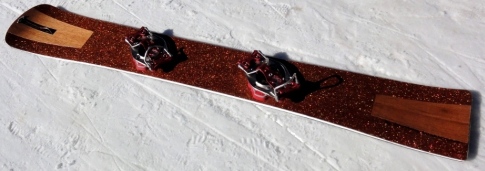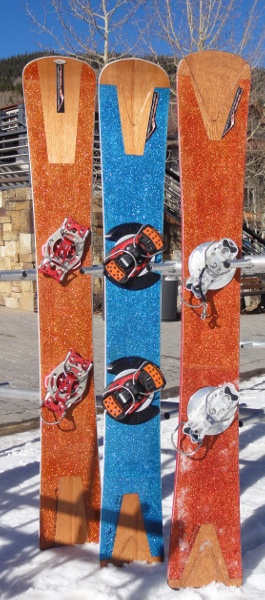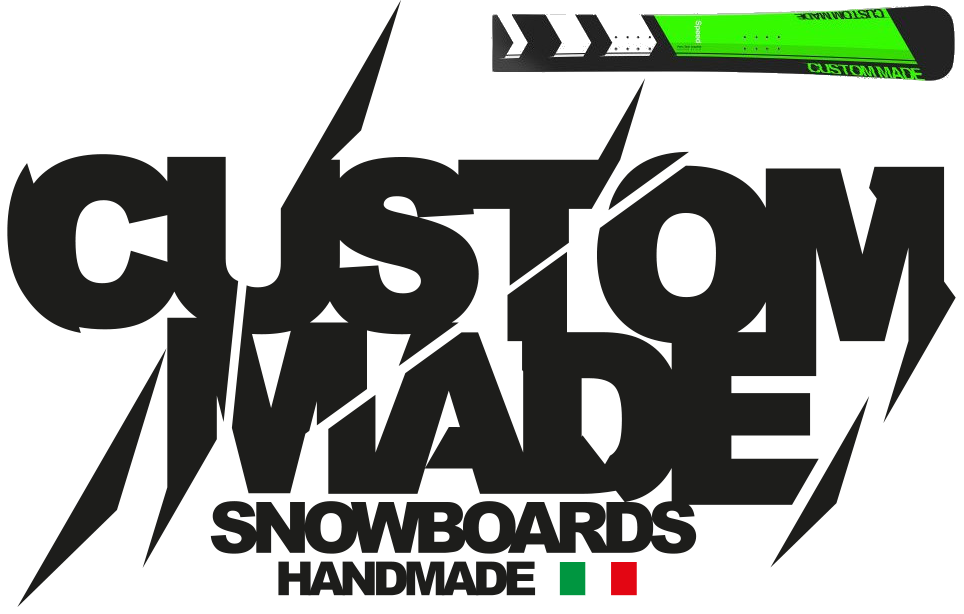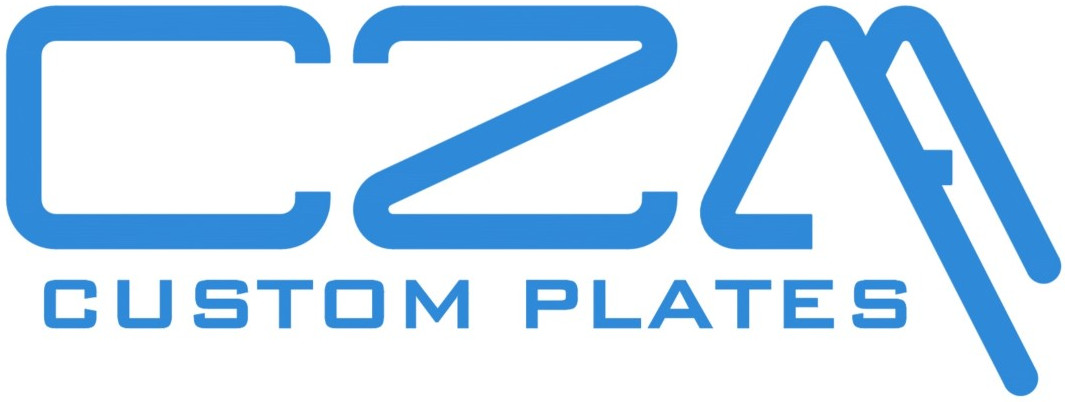Gromel Snowboards
1 Name , Family name , date of birth , profession , usual spot e/o preferred spot.
Aleksey Ostatnigrosh, software developer, snowboarding, beer drinking.
ALeksey Melnikow, software developer, snowboarding, binking.
2 Material used: boards , bindings , boots, helmet , goggles , clothing.
Carving custom made snowboards :
Olympic vertical laminated wood core
NHS racing base
Titanal
Fiberglass, Carbon
3 Since when you are on hard snowboarding.
Since 1989
4 Why hard?
Hard boot snowboard gives you unique opportunity to feel and controll every turn you make.
In comparison with other sports it reminds racing truck motorcycle or even formula 1 car .
Such technique is not for every one, but if you like to race the lotus Elise or Yamaha bike on race truck it is your sport.
5 What do you think about new tecnologies: decamber, rocker, taper, multi radius, materials such as carbon fiber and titanal , plates.
I personally think that Titanal material used in the board long with rubber gives certain positive effect on high speed turns. Unfortunately using of this material decreasing board life span but neither one of racing cars has long life.
6 What could help the raise back of the hard snowboarding.
I think this sport like any other sport is requiring kinds education and ability to race on competitions since the young age.
7 Training techniques.
I'm not the coach.
8 Whath to say at whom is starting.
Buy the helmet,body armor and turn your head 360 degrees in order to avoid colliding with other people on the slope.
9 Whath to say at whom has already.
Buy the helmet,body armor and turn your head 360 degrees in order to avoid colliding with other people on the slope.
Remember you are very fast boarder , your angle speed is extremely high.
As the result: factors such lying on the snow once turning and going across the slope in the same time makes you potentially dangerous to other people on the slope.



GROMEL Snowboards.
In 1976, being 12 years old, I used to toboggan. Once I saw something unusual on the slope. It was a forty year old man riding a wide and short ski made of a solid plastic sheet with a rope attached to the front of the ski. The man couldn’t turn very well, but managed to brake by pulling onto the rope and shifting his weight back. I went to say hi and found out that the man’s name was Boris Ivanovich Kovalev. However, no one called him by his full name. For local kids he was simply Bor. He was making such skis and also short skis with a seat attached (and giving them to kids for free). The only condition was to be able to ride one. As I later found out, he borrowed the idea of a snurfer at the “Sport and Recreation in the USA” exhibition in Moscow. Bor spent a lot of time with kids on the slopes. He is rightly considered to be the first to ride a ski sideways in Russia.
I got my snurfer in 1980 and my friend Alex Melnikov got his a year later. We rode snurfers for about 5 years but something was missing. It was ability to jump. So I attached a stiff rubber cable to the tail of the board. This allowed us to jump while holding the board with both hands.
By 1985 after making several alterations I realised that ropes and rubber cables should be dropped in favour of attaching the board to the feet somehow. So I made a set of bindings using an alloy plate and rubber bands which were attached by a single bolt in the centre. That allowed for on the snow quick angle adjustments as well as for easy switching from regular to goofy. I believe such design appeared in the rest of the world several years later. These days most bindings have incremental quick angle adjustments.
At the same time first western snowboard magazines started circulating in Moscow. .
In 1988 we got our hands on the snowboard with ski-like construction for the first time. It was Barfoot Freestyle 144. Someone called Gleb Secrette received it as a gift from his mom who lived in Canada.
We immediately realised how far we lagged behind the western industry. So we rushed to find anyone in Russia who knew how to make skis. I must say that we were very fortunate in meeting people – true enthusiasts of winter sports:
Vladimir Maslachenko – former soccer goalkeeper, well known TV sports presenter and a president of a ski club. He brought the BARFOOT 144, from Calgary Olympics for Gleb and gave us Glebs contact details.
Gleb Secrette – having never seen or having heard of us before, trusted us with his most valuable posession solely based on our promise not to pull Barfoot apart to see what s inside and only to take measurements and measure flex.
Mr. Gusev – being a senior sports official, helped us with getting magazines and other info about skiing and snowboarding through the Iron Curtain.
Our parents – had to put up with all the mess in the apartments for years until we managed to rent a workshop.
Mr. Starcev – vice president of Ski and Freestyle Federation helped us with referrals while we were searching for materials. He also introduced us to Valerii Evseev.
Valerii Evseev – at the time worked on the development of ski manufacturing technologies in a ski factory in Moscow. He helped us with getting base material and some edges, explained how a real ski press worked and wished us good luck.
Valera Novikov – skater, skier, and a joiner by trade, made a mould for us and a wood core.
On the 1st of April 1988, the first russian snowboard was tested by myself and Gleb Secretta on the remainder of spring snow near the village of Mihanki 60km from Moscow. Results were promising.
That was the birthday of Gromel (OstatniGROsh and MELnikov) snowboard company.
For the first year we made the boards in my parents flat. Severe lack of space and proper equipment made life interesting.
The mould, piles of materials and tools covered in dust resided in my bedroom. Glass fibers mixed with my dogs’ hairs were floating in the air. Anyone involved in OH&S would’ve had a heart attack.
For the next year my friend Melnikov hosted the mould in his parents flat.
We were making more and more boards. Our parents started losing their patience. So we moved. We rented a room in the local school where Bor worked as an electrician and organised a snowboard club.
At the time our main model was a 152 freestyle board with sandwich core construction. br /> We also made a couple of 175 all-mountain boards with vertically laminated cores. Boards proved to be robust, customers were happy with their performance. One thing was missing – good graphical design.
That was when we met Alexei Savichev, a man of free spirit and no particular trade, later known as Designer. He started painting our, in his own words, "rubbish". Actually, he did it quite well, combining spray painting, screen printing and other non-orthodox freehand methods. Our sales went up.
The lack of proper equipment became obvious again. So we went back to the experts. Valerii Evseev drew us a diagram of a Makron ski press and wished good luck for the second time.
In about a month time the press was ready. It consisted of two 1940s model paper recycling presses, about half a ton each, lots of steel in-between, adjustable alloy mould, pressure distribution lining from the printing industry. Heating was done by ice-melting elements from the wings of a MIG-27 fighter.
With this press the time it took to make a board was reduced threefold.
More people joined us – Michail Studencov – production supervisor, Sergei Knyazev, and Andrei Volchkov – currently a competing snowboarder.
Business was pretty good in winter and not too good in summer, but we kept going.
We found people who could make polyurethane soft binding and titanium plate binding. .
The manufacturing infrastructure was still intact after the crash of socialism, but it was almost in an idle state.
In 1992 we sponsored the first snowboard slalom competition in Moscow. Matcukevich from St.Petersburg took the first place. I took the second, Melnikov – the third. Designer took a place in an ambulance – he dislocated his shoulder.
Around the same time we rented a section of a sport shopfront window in Gorky street in the centre of Moscow. Designer did the backdrop. Lighting was supplied by Lenins Historical museum. What an irony!
For a few years that window was the only russian company ad in the street.
By 1993 the crime situation in Russia got worse. Many private companies were "advised to buy protection". We weren t big enough to afford it. So we sold our business to a bigger, protected company, which made wind surfers and needed a product to sell during winter. Unfortunately, they never made a single snowboard and all the equipment turned into a pile of rust.
My friend Melnikov and his wife migrated to Australia in 1993. He worked for a year making snowboards at "Planet Snowboards" near Canberra, but then got a job in computing. I, together with Michail Studencov, recreated snowboard business in the basement of the block of flats were we lived. The new company was named GROSTU. Our experience, desire to make boards, and top of the line materials brought from Austria allowed us to make high quality product, but we didn t make many.. In 1994 my parents and I migrated to the USA. I tried to work in the snowboard industry, but that didn t last long. After a while I got a job in IT – became a web developer.
The last of my GROSTU boards lasted for more than five years. In 1999 I switched to a Volkl Renntiger 168 – the first board in my life that I didn t make.
Aleksey Ostatnigrosh (with some editing help from Alexei Melnikov and





